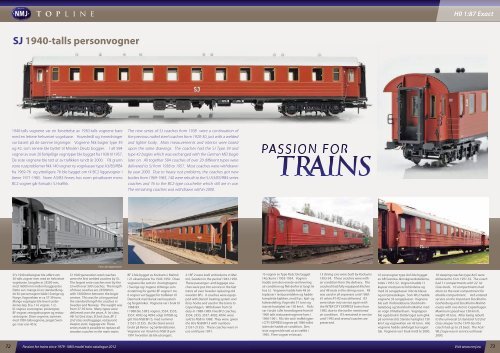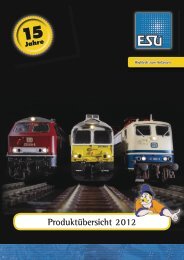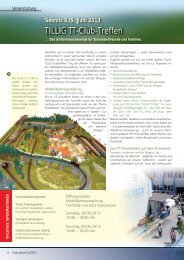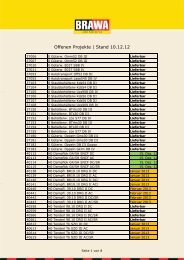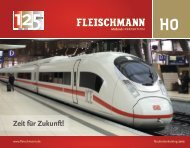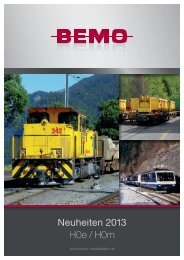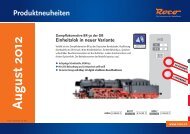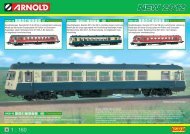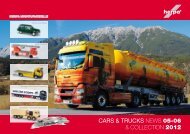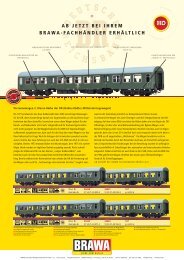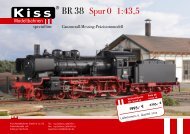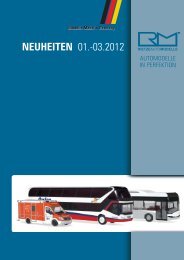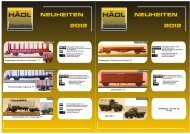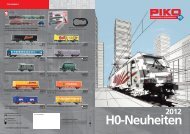H0 1:87 Exact - Modellbahnshop Sebnitz
H0 1:87 Exact - Modellbahnshop Sebnitz
H0 1:87 Exact - Modellbahnshop Sebnitz
- No tags were found...
You also want an ePaper? Increase the reach of your titles
YUMPU automatically turns print PDFs into web optimized ePapers that Google loves.
WWW.NMJ.EUE S T A B LI S H E D 1 9 7 9topline<strong>H0</strong> 1:<strong>87</strong> <strong>Exact</strong>SJ 1940-talls personvogner1940-talls vognene var en forsettelse av 1930-talls vognene baremed en lettere helsveiset vognkasse. Hovedmål og innredningervar basert på de samme tegninger. Vognene fikk bogier type 39og 42, som senere ble byttet til Minden Deutz boggier. I alt 584vogner av over 20 forkjellige vogntyper ble bygget fra 1938 til 1957.De siste vognene ble tatt ut av trafikken rundt år 2000. På grunnstore rustproblemer fikk 140 vogner ny vognkasser type A3/B3/RB4fra 1969-76 og ytterligere 76 ble bygget om til BC2 liggevogner iårene 1971-1985. Noen A3/B3 finnes hos noen privatbaner mensBC2 vogner går fortsatt i SJ-trafikk.The new series of SJ coaches from 1938 were a continuation ofthe previous nailed steel coaches form 1920-30, just with a weldedand lighter body. Main measurements and interior were basedupon the same drawings. The coaches had the SJ Type 39 andtype 42 bogies which was exchanged with the German MD bogielater on. All together 584 coaches of over 20 different types weredelivered to SJ from 1938 to 1957. Most coaches were withdrawnby year 2000. Due to heavy rust problems, the coaches got newbodies from 1969-1985, 140 were rebuilt to the SJ A3/B3/RB4 seriescoaches and 76 to the BC2-type couchette which still are in use.The remaining coaches was withdrawn within 2000.Foto: JärnvägsmueumSJ‘s 1940-tallsvogner ble utført som30-talls vogner men med en helsveisetvognkasse. Lengden er 23500 mm,med 16000 mm mellom boggisenter.Dette var i mange år en standardlengdefor personvogner både i Sverige ogNorge. Vognvekten er ca 37-39 tonn.Mange vogntyper ble levert underårenes løp, bl.a. 1 kl. vogner, 1./2.kl. vogner, sovevogner, postvogner,BF-vogner, reisegodsvogner og restaurantvogner.Disse vognene, sammenmed 1930-tallsvognene, preget Sverigei mer enn 40 år.SJ 1940 generation steel coacheswere the first welded coaches by SJ.The largest serie coaches ever by theSJ with over 500 coaches. The lengthof these coaches are 23500mm,with 16000mm between the bogiecentres. This was for a long periodthe standard length for coaches inSweden and Norway. The weight wasfrom 37-39 tons. Many types weredelivered over the years, A 1st class,AB 1st/2nd class, B 2nd class, BF 22nd class and luggage, restaurant,sleeper, post, luggage etc. Theseseries made it possible to replace allwooden coaches in the main trains.BF 2 ble bygget av Kockums i Malmöi 21 eksemplarer fra 1943-1950 Dissevognene ble satt inn i hurtigtogenei Sverige og i togene til Norge somerstatning for gamle BF vogner i tre.6 vogner var bygget for trafikken tilDanmark med dansk varmesystemog fergekroker. Vognene var i bruk til1988-89.I 1988 ble 5 BF2 vogner, 3554, 3555,3557, 4092 og 4094, solgt til NSB oggitt litra NSB BF15, med nummer21551-21555. De ble blant annetbrukt på Røros- og Sørlandsbanen.Vognene var i bruk hos NSB til juni1991 hvoretter de ble utrangert.21 BF 2 were built at Kockums in Malmö,Sweden in the period 1943-1950.These passenger- and luggage coacheswere put into service in the fasttrains all over Sweden replacing oldwooden BFs. 6 coaches were equippedwith Danish heating system andferry hooks and used in the trains toCopenhagen. Withdrawn from SJduty in 1988-1989. Five BF2 coaches,3554, 3555, 3557, 4092, 4094. weresold to NSB in 1988. They were giventhe litra NSB BF15 with numbers21551-21555. These coaches were inuse until june 1991.15 vogner av Type Ro3c ble byggeti Kockums i 1953-1954. Vognenhadde som den eneste ved leveringair condition og fikk derfor et langt livhos SJ. Vognene hadde hele 48 sitteplasseri restaurantdelen og haddekomplette kjøkken, med frys-, kjøl- ogkokeavdeling. Vognvekt 51 tonn ogstørste hastighet var 130 km/t. Ro3cvar i brukt i alle hovedtogene fram til1960 talls restaurantvognene kom i1960-1961. R3c ble satt i trafikk igjeni CITY EXPRESS togene på 1980-talletsiden de hadde air condition. Densiste vognen ble tatt ut av trafikk i1995. Flere vogner er bevart.15 dining cars were built by Kockums1953-54. These coaches were withair condition from the delivery. Thecoached had fully equipped kitchenand 48 seats in the dining room. R3was used in all expresses until 1960-61 when R1-R2 was delivered. R3were taken into service again withthe INTER CITY EXPRESS trains from1985, due to the earlier mentionedair condition. R3 remained in serviceuntil 1995 and several coaches arepreserved.10 sovevogner type Ao5 ble byggetav AB Svenska Järnvägsverkstäderna,Arløv i 1951-52. Vognen hadde 11kupeer med parvis forbindelse ogmed 22 sengeplasser i første klasseog en tjenestekupe. Som WL2 haddevognene 33 sengeplasser. Vogneneble satt i forbindelsene Stockholm-Gøteborg og Stockholm-Malmö meden vogn til København. Vogntypenble også brukt i Dollartoget som gikkpå sommerstid. Største hastighet 130km/t og vognvekten var 45 tonn. Allevognene hadde sølvfarget korrugerttak. Vognene var i bruk inntil år 2000.10 sleeping coaches type Ao5 weredelivered to SJ in 1951-52. The coachhad 11 compartments with 22 1stClass beds. 10 compartments haddoors to the next compartment fordouble compartment. Ao5 enteredservice on the important Stockholm-Gothenburg and Stockholm-Malmöroutes with one Ao5 to Copenhagen.Maximum speed was 130 km/h,weight 45 tons. After being rebuiltto the universal SJ standard 1st/2ndClass sleeper in the 1970-ties thecoach had up to 33 beds. The Ao5/WL2 type was in service until year2000.72Passion for trains since 1979 - NMJ model train catalogue 2012Visit www.nmj.eu73


